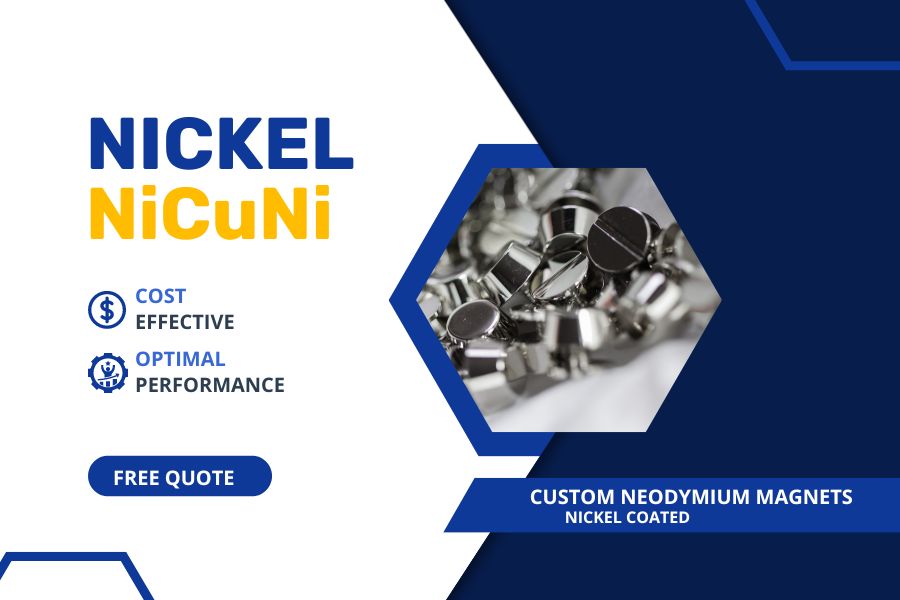Thinking about ordering custom neodymium magnets?
The coating you choose matters more than you might think.
Neodymium magnets pack serious magnetic power in small packages.
But without the right coating, these workhorses can fail early.
Let’s look at why nickel plating is the top choice for protecting these powerful magnets.
Table of Contents
Why Your Neodymium Magnets Need Protection
Neodymium magnets contain about two-thirds iron.
This makes them rust easily when exposed to moisture or humid air.
- Without protection, they corrode over time, losing magnetic strength and structural integrity.
These magnets are also brittle.
- A protective layer helps prevent chips or cracks from everyday handling.
With proper coating, your magnets keep a stable magnetic field much longer, extending their useful life.
What Is Nickel Plating?
While often called simply “nickel coating,” the standard approach is actually a triple-layer plating:
- Outer nickel layer: Gives hardness and rust protection with an attractive metal finish
- Middle copper layer: Improves sticking and acts as a barrier between nickel layers, filling tiny pores
- Inner nickel layer: Creates a strong bond directly with the magnet surface
This structure is called “Ni-Cu-Ni” coating. The total thickness is typically 10-20 micrometers (μm), with each layer about 5-7 μm thick.
Nickel plating has been the industry standard since the mid-1990s.
- It replaced single-layer nickel coatings that needed 20-25 μm thickness for good protection.
- The multi-layer approach fights corrosion better while using less nickel.
- The copper middle layer greatly improves the overall quality by smoothing the surface and sealing tiny pores.
Beyond standard Ni-Cu-Ni, there are options like black nickel, which has the same structure but looks black or dark grey.
- For specific uses, you can get specialty coatings like gold-plated (Ni-Cu-Ni-Au), chrome-topped (Ni-Cu-Ni-Cr), or tin-topped (Ni-Cu-Ni-Sn).
How Manufacturers Apply Nickel Plating
The coating process involves several careful steps:
Surface Preparation
Magnets get thoroughly cleaned to remove dirt or rust.
A chemical etching step helps the bare magnet bond properly with the plating.
This prep is key for good sticking.
Electroplating
The magnets go into a plating bath with the magnet acting as the cathode.
Electric current flows through, causing nickel (and other metals in the stack) to stick to the surface.
Makers control voltage, current, temperature, and chemical mix for consistent results.
The process needs careful control, as plating tends to build up more on edges and less in tight corners.
Post-Plating Treatment
Coated magnets usually get heat treated to relieve stress and ensure strong adhesion.
This baking helps strengthen the bond between the coating and magnet.
Final checks look for even thickness and surface finish using methods like X-ray fluorescence or magnetic thickness gauges.
Electroless Nickel Plating
Some makers offer electroless nickel plating as an option.
This chemical process doesn’t need electric current and gives more even coating on complex shapes.
The resulting Ni-P (nickel-phosphorus) alloy covers well even in recesses, blind holes, and tight corners where electroplating struggles due to lack of line-of-sight for plating current.
- For magnets with complex shapes, electroless nickel can be essential for complete protection.
Benefits You’ll Get From Nickel-Coated Magnets
Choosing nickel-coated neodymium magnets gives you several key benefits:
- Effective Corrosion Protection: Nickel creates a barrier against moisture and chemicals that would damage raw magnets. In normal indoor settings, proper nickel plating can protect magnets for many years.
- Enhanced Durability: The coating increases resistance to scratching, chipping, and physical damage. Nickel handles shock and impact better than many other coatings, helping your magnets stay intact during handling.
- Professional Appearance: Nickel plating gives magnets a smooth, metallic shine that looks great in consumer products. The silver finish provides a high-quality look.
- Stronger Bonding: The copper middle layer improves the overall bond strength between the coating and magnet surface, making sure the plating doesn’t flake or peel under normal use.
- Temperature Stability: Nickel plating stays stable up to about 200°C, which exceeds the maximum working temperature of standard neodymium magnets (typically 80-150°C). This makes the coating good for applications with moderate heat.
- Cost-Effective Solution: Nickel plating adds only a small cost to each magnet while providing excellent all-around protection. It offers a balanced mix of corrosion resistance, surface hardness, good adhesion, and reasonable cost.
Electrical Conductivity: Unlike some other coatings like epoxy, nickel plating conducts electricity – a benefit for certain applications where electrical contact is needed.
Important Considerations When Ordering
When choosing nickel-plated neodymium magnets for your project, keep these factors in mind:
Coating Thickness
- Standard Ni-Cu-Ni coatings have a total thickness of about 15 μm.
Thicker coatings generally protect better but can affect size tolerances and slightly reduce magnetic strength relative to size.
For very small magnets, the plating thickness can significantly impact final dimensions.
Environmental Exposure
While great for indoor use, standard nickel plating may not be enough for harsh outdoor environments.
- In salt spray tests (ASTM B117, run at about 35°C with saltwater mist), typical Ni-Cu-Ni plating lasts about 24 hours before showing first signs of rust.
- The humidity test or pressure cooker test (PCT) is even tougher (120°C at 2 atm steam), where a good Ni-Cu-Ni coating might last about 48 hours before corrosion spots appear.
Temperature Sensitivity
In high-heat environments, the plating may become stressed.
While nickel can handle temperatures up to 200°C, quick temperature changes can cause stress between the coating and magnet due to different expansion rates.
The magnet and nickel layer expand at different rates when heated, so frequent heating and cooling can eventually lead to tiny cracks in the plating.
Impact Resistance
While nickel coatings improve durability, the magnet inside remains brittle.
Repeated impacts can crack the coating and expose the core to corrosion.
Strong magnets snapping together can chip the plating at impact points.
Quality plating should pass a tape pull test (ASTM D3359, rating 4B or better), meaning minimal flaking even after the surface is scratched.
Adhesive Compatibility
Nickel’s smooth surface can be tricky for some adhesives.
- Super glue sometimes doesn’t bond well long-term on nickel – it might pop off under shock.
- Epoxy adhesives generally work better but need surface prep.
For critical applications, the surface typically needs light sanding or a phosphate coating to improve bonding.
- Glue tests show that black epoxy coatings often have better adhesive bonding than bare nickel.
Corrosion Protection Enhancement
Adding an epoxy layer on top of nickel can extend salt spray life to 48-72 hours, which is often needed for automotive or outdoor applications.
The energy industry commonly uses “KTL coating” (cathodic epoxy) over nickel for offshore wind turbines to handle marine environments.
Alternative Options
Depending on your specific environment, other coatings might work better:
- Epoxy coating: Offers better corrosion resistance in wet environments
- Zinc coating: Alternative for certain applications
- Gold plating (Ni-Cu-Ni-Au): For medical or skin contact applications (nickel causes allergies in some people)
- Chrome topcoat (Ni-Cu-Ni-Cr): For improved wear resistance in high-friction applications
- Tin topcoat (Ni-Cu-Ni-Sn): Better for adhesive bonding but softer than pure nickel
- Parylene coating: For biocompatible applications
- Electroless nickel: For complex shapes with recesses and blind holes
Working Conditions: Where Nickel-Plated Magnets Excel
Nickel-plated magnets work best in these environments:
Dry Indoor Settings
In typical room conditions (20-25°C, low humidity), Ni-Cu-Ni coating can protect a magnet indefinitely.
The nickel doesn’t tarnish or degrade in clean, dry air.
That’s why most magnets in indoor electronics, office devices, and household gadgets use this coating – they stay shiny and rust-free for years.
Moderate Humidity
Nickel plating handles day-to-day humidity very well.
It can deal with normal humidity levels and even occasional water splashes, as long as the magnet isn’t left wet for long periods.
- For example, if a nickel-plated magnet gets briefly wet and is dried off, it’ll be fine; water won’t get through unless the coating is damaged.
Mildly Elevated Temperatures
The plating stays protective at temperatures up to around 200°C.
- This heat stability makes nickel plating good for many industrial uses where heat is present (like an engine compartment at 80°C or an electric motor at 120°C).
The nickel coating won’t melt, soften, or significantly oxidize at these temperatures.
Low-Wear Situations
In applications where the magnet isn’t constantly rubbed or scraped, the nickel plating will last for years.
Nickel’s hard, smooth surface doesn’t collect dust and is easy to clean if needed.
Stationary or gently handled magnets (in sensors, couplings, etc.) are ideal applications.
Chemically Neutral Surroundings
Nickel plating doesn’t react much with air, oils, many plastics, gasoline, kerosene, alcohol, and many solvents.
Nickel-plated magnets submerged in oil (common in some machines or dampers) do fine; the oil actually helps keep water out and nickel doesn’t react with oil.
- This makes nickel-plated magnets great for use in gearboxes, sealed bearing assemblies, or applications with lubricants.
Protected Outdoor Use
If a nickel-plated magnet must be used outdoors, the best setup is having it protected from direct exposure.
When kept inside a waterproof case or coated with a sealant, the nickel plating acts as a second line of defense.
- For example, a nickel-plated magnet embedded in a plastic housing on a vehicle might experience temperature swings
- But if moisture is kept out, the plating will still work well.
Short-Term Exposure to Adverse Conditions
In temporary or occasional harsh conditions, nickel plating provides good short-term protection.
For instance, if exposed to mild acids or bases occasionally (like cleaning solutions), the nickel won’t immediately fail.
- Standard Ni-Cu-Ni plating can handle about 24 hours in salt spray tests and around 48 hours in humidity tests (PCT – pressure cooker test) before showing signs of corrosion.
Electrical Applications
Since nickel conducts electricity, these magnets are ideal where electrical conductivity is needed.
- For example, if your magnets need to create an electrical contact or be part of a circuit, nickel plating allows this while still providing corrosion protection.
Some applications even use nickel-plated magnets as solderable components.
Where Nickel-Plated Magnets May Need Additional Protection
Consider extra protective measures in these tough conditions:
Prolonged High Humidity or Immersion
Long exposure to water, especially salt water, will eventually cause corrosion. Marine environments are particularly harsh.
Outdoor use with direct rain exposure or submersion in water is beyond what plain nickel plating can handle long-term.
Aquarium or reef tank magnets with only nickel plating will rust badly in saltwater.
Rapid Temperature Cycling
Fast changes in temperature can stress the bond between the magnet and coating due to different expansion rates.
- Going from room temperature to near 150°C and back repeatedly might eventually weaken the bond.
- Thermal shock (like dunking a hot magnet into cold water) can crack both the magnet and the plating.
High-Wear Applications
Direct impacts, sliding contact, or continuous rubbing will eventually wear through the coating.
If a nickel-plated magnet is constantly sliding against a surface (especially another metal), the plating will wear through over time.
High-vibration environments can also cause wear or fatigue in the plating, especially at edges.
Strong Chemical Exposure
Nickel will dissolve in strong acids like nitric acid and can be attacked by strong bases.
Even vinegar (weak acid) over a long time might erode it.
Chlorine (like bleach or pool water) can pit nickel.
If a magnet is part of an electrical circuit in liquid, galvanic corrosion of nickel can occur.
Direct Skin Contact
Nickel causes allergies in some people, leading to skin rashes in sensitive individuals.
For wearables or items with prolonged skin contact, additional coatings are recommended.
Human sweat is slightly salty and acidic, which can over time corrode nickel plating in the presence of air.
Medical Sterilization
Repeated steam sterilization (autoclaving at 121°C, 100% humidity) is extremely harsh on nickel plating.
Standard Ni-Cu-Ni might survive a few cycles but could fail after many cycles as moisture seeps in.
Common Applications Where Nickel-Plated Magnets Excel
Nickel-coated neodymium magnets perform exceptionally well in many areas:
Consumer Electronics
You’ll find these magnets in speakers, headphones, hard drives, phone vibration motors, and sensors. These indoor, controlled environments with moderate temperatures (up to 60-80°C) are perfect for nickel plating. The thin coating (about 15 μm) doesn’t significantly affect size tolerances, which is crucial for these precision uses.
Automotive Components
Used in electric motors (for EV traction motors or hybrids), sensors (position, speed), speakers, actuators (for valves or locks), and magnetic couplings.
In these applications, high-quality nickel plating must pass 48-72 hour salt spray resistance tests to handle road salt exposure.
Automotive-grade magnets often have extra protection like epoxy over nickel for corrosion insurance, especially for under-hood areas that can reach 150°C.
Medical Devices
Found in MRI machines, surgical tools, hearing aids, and external medical devices.
For these applications, special electroless nickel plating or additional coatings are used to improve sterilization resistance.
Gold plating over nickel (Ni-Cu-Ni-Au) is common for parts with potential skin or tissue contact, while parylene coating over nickel provides biocompatibility for some medical uses.
Energy Industry
Used in wind turbines (particularly large generators), magnetic bearings, flywheels, and wave/tidal power generators.
For offshore applications, nickel plating is typically combined with epoxy coating (often called KTL or cathodic epoxy coating) for maximum corrosion protection in marine environments.
Magnetic couplings in pumps for chemical or oil pipelines also use nickel-plated magnets.
Industrial Equipment
Motors, generators, and sensors benefit from nickel plating’s temperature stability and resistance to oils and many industrial fluids.
The plating remains stable up to 200°C, which exceeds the typical operating temperatures for most industrial applications (60-100°C).
Consumer Products
Hobby magnets, magnetic toys/puzzles, cabinet latches, magnetic phone mounts, and other everyday items typically use nickel plating for its attractive look and adequate protection in normal conditions.
For decorative applications, black nickel (with the same structure as standard Ni-Cu-Ni but with a dark appearance) is sometimes used for aesthetic reasons.
Practical Tips for Using Your Nickel-Plated Magnets
To get the most from your investment:
- Handle With Care: Use gloves or clean, dry hands to avoid getting oils or moisture on the magnet surface. Skin oils can lead to corrosion over time. Don’t let magnets snap together forcefully, as impact can chip the coating, especially at edges.
- Inspect Regularly: Visually check coatings for cracks or pits after impacts. Even minor damage can lead to corrosion if moisture gets in. If a nickel coating is scratched or chipped, consider re-coating or throwing away the magnet if rust begins to appear.
- Store Properly: Keep magnets in a dry place, ideally in sealed containers with desiccant if humidity is high. For long-term storage, a controlled environment works best. This matters most for magnets that will be used in critical applications.
- Surface Preparation for Bonding: If you’re gluing nickel-plated magnets, lightly sand or roughen the surface for better adhesion. Epoxy adhesives generally work better than super glue. For the strongest bond, consider using a primer designed for metal surfaces or choose magnets with a tin topcoat (Ni-Cu-Ni-Sn) which improves adhesive bonding.
- Additional Protection for Harsh Environments: If your application involves outdoor use or exposure to moisture, consider applying an extra protective coating like epoxy or sealant. For aquarium use or regularly wet environments, complete encapsulation in plastic or epoxy is recommended.
- Quality Testing: For critical applications, consider requesting certification of plating thickness using non-destructive measurement tools (X-ray fluorescence) to verify plating thickness and uniformity. The tape pull test (ASTM D3359, rating 4B or better) ensures good adhesion, while salt spray test results (ASTM B117) or humidity test results indicate corrosion resistance.
- Mounting Considerations: In high-vibration environments, make sure magnets are mounted securely to prevent movement that could cause coating wear. For applications with repeated thermal cycling, use mounting methods that allow for thermal expansion and contraction.
Making the Right Choice
Nickel coating protects neodymium magnets from corrosion and wear.
- For indoor use, standard nickel plating works great.
- For harsh environments, ask about enhanced options.
Need custom strong magnets?
Contact us to discuss your project needs.



